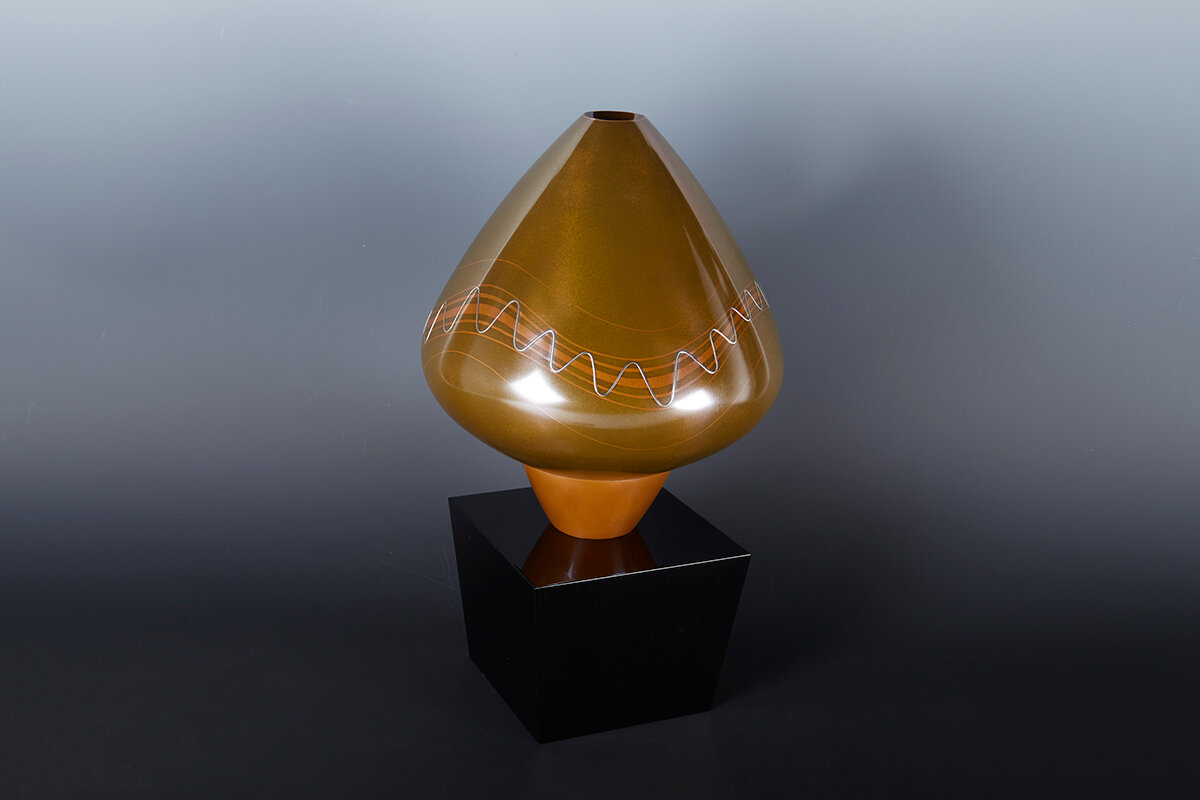POST-WAR & CONTEMPORARY
MID CENTURY FLOWER VASE BY KANAMORI EIICHI
Sculptural vase in an ovoid, bead-like form with swirling line ornamentation, set on a square, black-lacquered wood stand. Of cast yellow bronze, inlaid in red bronze and silver. Signed on the reverse by the artist with a chiseled signature: Eiichi Saku or Made by Eiichi (Kanamori Eiichi, 1908 – 2001). Showa 31 or 1956.
With the tomobako or original box, inscribed on the exterior of the lid: Seido Zogan Kabin or Blue Bronze Inlaid Vase; and on the reverse of the lid: Showa Koshin Shoka, Koryo Kojin, Eiichi Saku or Showa (era), Year of the Monkey (1956), Artist of Takaoka, Made by Eiichi. With the original tomogire or wrapping cloth, signed: Eiichi Saku or Made by Eiichi, and sealed.
Inside the box is a handwritten document by the former owner, stating that he bought the vase in Tokyo at Marunouchi Bijutsu-ten (Marunouchi Art Store) on November 8 of Showa 28 (1963). The document then contains a brief summary of the Kanamori Eiichi’s career to that date, and states that the piece was exhibited in the Toyama Prefectural Exhibition in Showa 31 (1956), and is attested to with the artist’s seal.
Born in Takaoka, Toyama Prefecture, Kanamori Eiichi graduated from the Metalworking Department of the Toyama Prefectural Industrial Arts School. He studied under Ichihei Uchijima. Eiichi was first accepted as an exhibitor nationally at the 14th Teiten in 1933. In 1936, he showed at both the Kaiso Dai Ikkai Teiten and the Bunten Kansaten, then in 1940 at the Hoshukuten and in 1941 at the 4th Shin-Bunten. After the Pacific War, he continued to exhibit frequently at the Nitten, including at the 1st – 3rd in 1946 – 1947, at the 6th – 9th in 1950 – 1953, and at the 12th in 1956. He taught at the Takaoka Industrial Arts High School between 1941 and 1966. In 1976, he received the Japan Industrial Art Association Governor’s Award, and in 1980, he received an Order of the Sacred Treasure Award from the Emperor. In 1989, Eiichi was designated Juyo Mukei Bunkazai or Important Intangible Cultural Asset (commonly known as a Living National Treasure).
With this post-war sculpture, Eiichi turns traditional chasing and inlay techniques to abstract ends. Over a curving ground of yellow sentoku, he traces flowing lines of flush-inlaid red bronze. High-relief inlay of twisted silver wire scrolls jazzily over these bars, with an almost musical effect.
Mid Century Flower Vase by Kanamori Eiichi
Artist Name: Kanamori Eiichi
Period: Showa Post War
Mediums: Lacquer, Metalwork, Wood
Form: Vase
Origin Country: Japan
13 ¾” high x 8 ½” diameter, dimensions with stand
This piece is no longer available.





